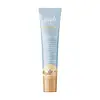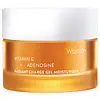What's inside
What's inside
 Key Ingredients
Key Ingredients

 Benefits
Benefits

 Concerns
Concerns

 Ingredients Side-by-side
Ingredients Side-by-side

Water
Skin ConditioningGlycerin
HumectantIsohexadecane
EmollientSaccharomyces Lysate
Skin Conditioning3-O-Ethyl Ascorbic Acid
Skin ConditioningSodium PCA
HumectantInositol
HumectantPolyacrylamide
Polysorbate 20
EmulsifyingPhenoxyethanol
PreservativeCarbomer
Emulsion StabilisingTriethanolamine
BufferingAlpha-Arbutin
AntioxidantTranexamic Acid
AstringentPanthenol
Skin ConditioningSodium Benzoate
MaskingC13-14 Isoparaffin
EmollientLaureth-7
EmulsifyingAllantoin
Skin ConditioningBeta-Glucan
Skin ConditioningVanilla Planifolia Fruit Oil
EmollientTocopheryl Acetate
AntioxidantTetrasodium EDTA
Foeniculum Vulgare Fruit Extract
EmollientHumulus Lupulus Extract
AntimicrobialMelissa Officinalis Leaf Extract
Skin ConditioningViscum Album Leaf Extract
SoothingChamomilla Recutita Flower Extract
MaskingAchillea Millefolium Extract
CleansingWater, Glycerin, Isohexadecane, Saccharomyces Lysate, 3-O-Ethyl Ascorbic Acid, Sodium PCA, Inositol, Polyacrylamide, Polysorbate 20, Phenoxyethanol, Carbomer, Triethanolamine, Alpha-Arbutin, Tranexamic Acid, Panthenol, Sodium Benzoate, C13-14 Isoparaffin, Laureth-7, Allantoin, Beta-Glucan, Vanilla Planifolia Fruit Oil, Tocopheryl Acetate, Tetrasodium EDTA, Foeniculum Vulgare Fruit Extract, Humulus Lupulus Extract, Melissa Officinalis Leaf Extract, Viscum Album Leaf Extract, Chamomilla Recutita Flower Extract, Achillea Millefolium Extract
Water
Skin ConditioningButylene Glycol
HumectantTrisiloxane
Skin ConditioningAmmonium Acryloyldimethyltaurate/Vp Copolymer
Trehalose
HumectantCyclopentasiloxane
Emollient3-O-Ethyl Ascorbic Acid
Skin ConditioningAllantoin
Skin ConditioningAdenosine
Skin ConditioningActinidia Polygama Fruit Extract
Skin ConditioningPhenoxyethanol
PreservativeAscorbic Acid
AntioxidantDimethicone
EmollientPolyglyceryl-3 Methylglucose Distearate
EmulsifyingPolysorbate 20
EmulsifyingDisodium EDTA
Ethylhexylglycerin
Skin ConditioningDimethicone/Vinyl Dimethicone Crosspolymer
Skin Conditioning1,2-Hexanediol
Skin ConditioningChondrus Crispus Powder
AbrasiveSynthetic Fluorphlogopite
Agar
MaskingAcrylates/C10-30 Alkyl Acrylate Crosspolymer
Emulsion StabilisingTromethamine
BufferingGellan Gum
Trideceth-9
EmulsifyingPEG-40 Hydrogenated Castor Oil
EmulsifyingParfum
MaskingSqualane
EmollientCI 77891
Cosmetic ColorantCI 77492
Cosmetic ColorantCI 19140
Cosmetic ColorantCI 14720
Cosmetic ColorantWater, Butylene Glycol, Trisiloxane, Ammonium Acryloyldimethyltaurate/Vp Copolymer, Trehalose, Cyclopentasiloxane, 3-O-Ethyl Ascorbic Acid, Allantoin, Adenosine, Actinidia Polygama Fruit Extract, Phenoxyethanol, Ascorbic Acid, Dimethicone, Polyglyceryl-3 Methylglucose Distearate, Polysorbate 20, Disodium EDTA, Ethylhexylglycerin, Dimethicone/Vinyl Dimethicone Crosspolymer, 1,2-Hexanediol, Chondrus Crispus Powder, Synthetic Fluorphlogopite, Agar, Acrylates/C10-30 Alkyl Acrylate Crosspolymer, Tromethamine, Gellan Gum, Trideceth-9, PEG-40 Hydrogenated Castor Oil, Parfum, Squalane, CI 77891, CI 77492, CI 19140, CI 14720
Ingredients Explained
These ingredients are found in both products.
Ingredients higher up in an ingredient list are typically present in a larger amount.
You might know this ingredient as Ethyl Ascorbic Acid, a more stable version of ascorbic acid.
Like other types of vitamin C, this ingredient has many benefits including reducing wrinkles, skin soothing, dark spot fading, and fighting against free radicals.
3-O-Ethyl Ascorbic Acid interferes with the process of skin darkening, helping to reduce hyperpigmentation. It also encourages the skin to produce more collagen.
Once applied, 3-O-Ethyl Ascorbic Acid is converted to Vitamin C deeper in the skin's layers. This process is slow but makes this ingredient more tolerable for skin.
The optimum pH range for this ingredient is 4 - 5.5
Learn more about 3-O-Ethyl Ascorbic AcidAllantoin is a soothing ingredient known for its protective and moisturizingg properties. Because of this, it is often added to products with strong active ingredients.
Studies show higher concentrations of this ingredient can promote wound healing.
Though it can be derived from the comfrey plant, allantoin is produced synthetically for cosmetic products to ensure purity.
Learn more about AllantoinPhenoxyethanol is a preservative that has germicide, antimicrobial, and aromatic properties. Studies show that phenoxyethanol can prevent microbial growth. By itself, it has a scent that is similar to that of a rose.
It's often used in formulations along with Caprylyl Glycol to preserve the shelf life of products.
Polysorbate 20 is made by combining ethoxylation of sorbitan, ethylene oxide, and lauric acid. It is a mild cleansing agent, surfactant, and emulsifier.
As a surfactant, it helps collect dirt and oils for washing. Emulsifiers prevent oils and water from separating.
Polysorbate 20 also adds scent to a product. Since it is made using sorbitol, it has a sweet scent. Sorbitol can also be found in fruits such as apples and peaches.
The lauric acid used to create Polysorbate 20 is often derived from coconuts.
Polysorbate 20 may not be fungal acne safe.
Learn more about Polysorbate 20Water. It's the most common cosmetic ingredient of all. You'll usually see it at the top of ingredient lists, meaning that it makes up the largest part of the product.
So why is it so popular? Water most often acts as a solvent - this means that it helps dissolve other ingredients into the formulation.
You'll also recognize water as that liquid we all need to stay alive. If you see this, drink a glass of water. Stay hydrated!
Learn more about Water